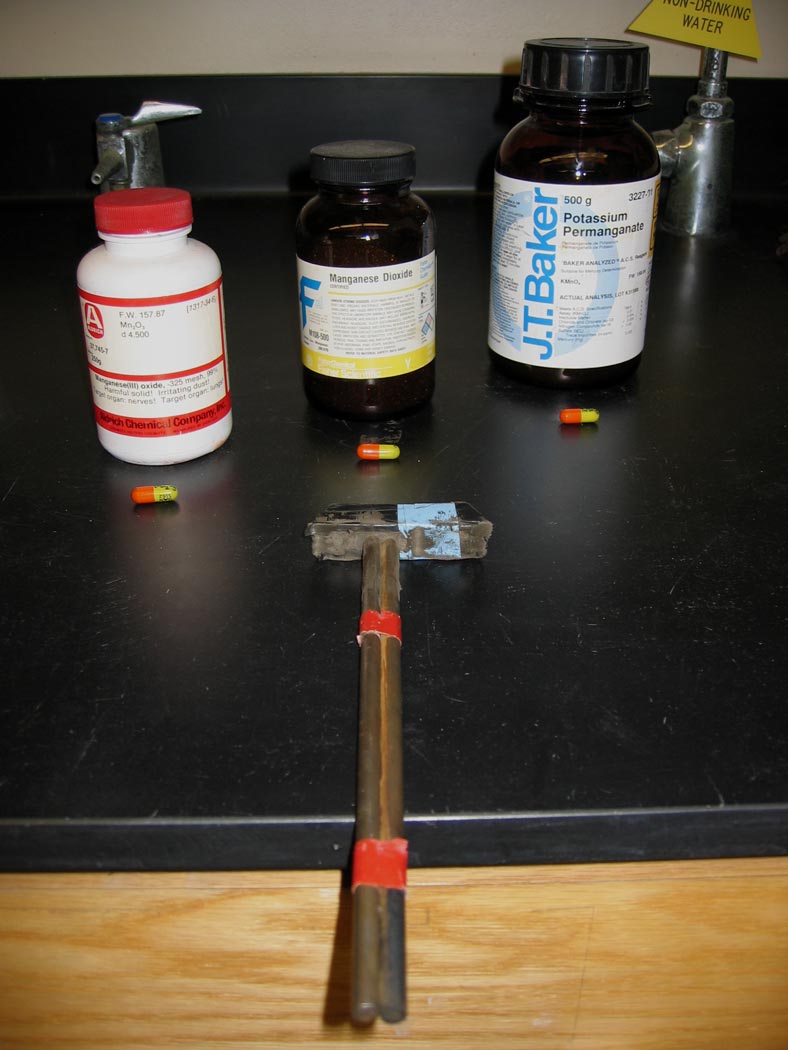Measuring paramagnetism in a series of manganese oxides
 A strong bar magnet is used to separate three oxides of manganese by exploiting their varying degrees of paramagnetism.
A strong bar magnet is used to separate three oxides of manganese by exploiting their varying degrees of paramagnetism.
Ingredients: manganese(IV) oxide, manganese(III) oxide, potassium permanganate, gelatin capsules, strong bar magnet
Procedure: A partial recipe follows.
1. Prepare three gelatin capsules, each containing one of the manganese compounds.
2. Arrange the capsules in a line.
3. Slowly bring the bar magnet close to the line of capsules until one capsule "steps forward."
4. Remove the capsule with the strongest paramagnetic response and repeat procedure.
Understanding: A paramagnetic compound is attracted to a permanent magnet. The paramagnetism of the atom or molecule is due to the existence of unpaired electrons in half-filled orbitals. The spin magnetic moment of the electron contributes to the overall paramagnetism of the atom or molecule. The more unpaired electron spins there are, the greater the magnitude of the paramagnetism.
To experimentally determine the relative degree of paramagnetism in the three manganese compounds, we segregate the compounds using the strong permanent magnet. We find that the manganese(III) oxide is most strongly attracted to the magnet, and therefore the most paramagnetic. The manganese(IV) oxide is the second most strongly attracted compound, and is paramagnetic. The permanganate shows no measurable attraction to the magnet, and appears to be diamagnetic.
To theoretically determine the paramagnetism of the compound, we must determine the electron configurations. Those electron configurations will tell us whether there are orbitals containing unpaired electrons, making the manganese paramagnetic, or not. The first step is to assign oxidation states to each of the atoms.
In each of the manganese compounds the oxygen assumes a -2 oxidation state; in the potassium permanganate, the potassium assumes a +1 oxidation state. We note that the oxygen and potassium atoms assume oxidation states that are consistent with each atom having a filled valence shell, characteristic of a diamagnetic rare gas atom. For example, the O(II) species has an electron configuration of
O2- 1s22s22p6 = [Ne]
and the K+ species has an electron configurationK(I) 1s22s22p63s23p6 = [Ar]
Both species are diamagnetic and so we ignore their contribution to any possible paramagnetism in the manganese oxides. That leaves manganese.The element manganese has atomic number 25. Following the rules defined by the Aufbau Principle, Pauli's Principle, and Hund's Rule, we find the neutral manganese atom has an electron configuration
Mn [Ar] 4s2 3d5
With five unpaired electrons we would predict that the manganese metal would be strongly paramagnetic. Now let's consider the oxides, starting with manganese(III) oxide which is Mn2O3. The manganese(III) species has 22 electrons; by our simple and powerful rules for forming electron configurations, we predictMn(III) [Ar] 4s2 3d2
Following similar reasoning, we predict that the manganese in manganese(IV) oxide would have an electron configurationMn(IV) [Ar] 4s2 3d1
In permanganate the manganese assumes a +7 oxidation state and is predicted to have a rare gas electron configurationMn(VII) [Ar]
The result of our theory is that the most paramagnetic compound would be manganese(III) oxide, with manganese(IV) oxide being more weakly paramagnetic. The permanganate is predicted to be diamagnetic. The predictions of our theory are in perfect agreement with our experimental observations.
Agreement between theory and experiment does not prove that the theory is correct!
Question: It turns out that the electron configurations predicted using the Aufbau Principle, Pauli Principle, and Hund's Rule are incorrect for the cases of Mn(III) and Mn(IV). We recall that elemental chromium exhibits the first deviation from the electron configurations predicted by these simple rules. For chromium, the rules lead to the prediction of a [Ar]4s23d4 configuration when the actual configuration is [Ar]4s13d5. Why is that? It turns out that the difference in energy between the 4s and 3d orbitals is small. There is a repulsion between the electrons paired in the 4s orbital that can be relieved by moving one electron from the 4s orbital into its own 3d orbital. That makes the [Ar]4s13d5 configuration lower in energy than the [Ar]4s23d4 configuration.It is known that the electron configuration of Mn(III) is [Ar] 3d4 while that of Mn(IV) is [Ar] 3d3. Do these electron configurations lead to different conclusions regarding the magnetism of the various compounds? Explain the electron configurations and the deviations from the standard rules.
You can check your answers here.